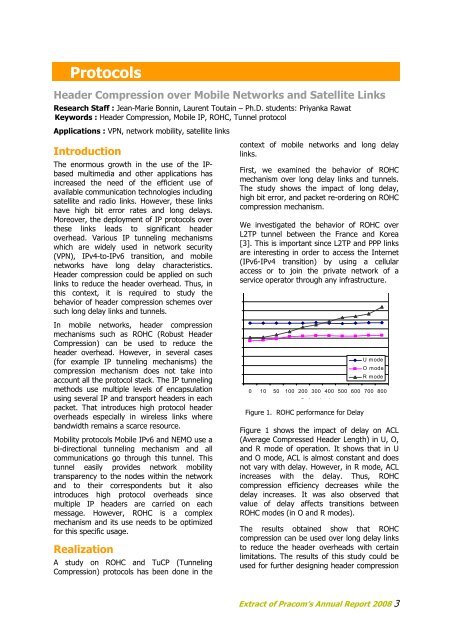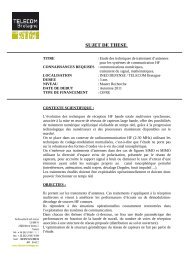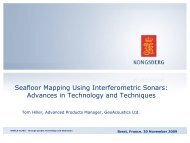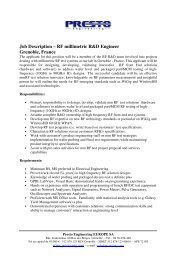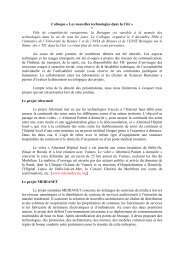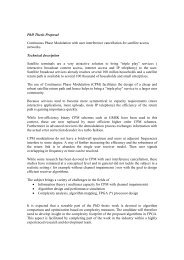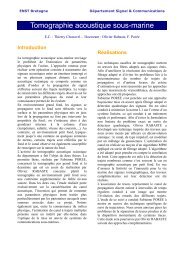Département Réseau, Sécurité et Multimédia Rapport d'Activités 2008
Département Réseau, Sécurité et Multimédia Rapport d'Activités 2008
Département Réseau, Sécurité et Multimédia Rapport d'Activités 2008
Create successful ePaper yourself
Turn your PDF publications into a flip-book with our unique Google optimized e-Paper software.
ProtocolsHeader Compression over Mobile N<strong>et</strong>works and Satellite LinksResearch Staff : Jean-Marie Bonnin, Laurent Toutain – Ph.D. students: Priyanka RawatKeywords : Header Compression, Mobile IP, ROHC, Tunnel protocolApplications : VPN, n<strong>et</strong>work mobility, satellite linksIntroductionThe enormous growth in the use of the IPbasedmultimedia and other applications hasincreased the need of the efficient use ofavailable communication technologies includingsatellite and radio links. However, these linkshave high bit error rates and long delays.Moreover, the deployment of IP protocols overthese links leads to significant headeroverhead. Various IP tunneling mechanismswhich are widely used in n<strong>et</strong>work security(VPN), IPv4-to-IPv6 transition, and mobilen<strong>et</strong>works have long delay characteristics.Header compression could be applied on suchlinks to reduce the header overhead. Thus, inthis context, it is required to study thebehavior of header compression schemes oversuch long delay links and tunnels.context of mobile n<strong>et</strong>works and long delaylinks.First, we examined the behavior of ROHCmechanism over long delay links and tunnels.The study shows the impact of long delay,high bit error, and pack<strong>et</strong> re-ordering on ROHCcompression mechanism.We investigated the behavior of ROHC overL2TP tunnel b<strong>et</strong>ween the France and Korea[3]. This is important since L2TP and PPP linksare interesting in order to access the Intern<strong>et</strong>(IPv6-IPv4 transition) by using a cellularaccess or to join the private n<strong>et</strong>work of aservice operator through any infrastructure.In mobile n<strong>et</strong>works, header compressionmechanisms such as ROHC (Robust HeaderCompression) can be used to reduce theheader overhead. However, in several cases(for example IP tunneling mechanisms) thecompression mechanism does not take intoaccount all the protocol stack. The IP tunnelingm<strong>et</strong>hods use multiple levels of encapsulationusing several IP and transport headers in eachpack<strong>et</strong>. That introduces high protocol headeroverheads especially in wireless links wherebandwidth remains a scarce resource.Mobility protocols Mobile IPv6 and NEMO use abi-directional tunneling mechanism and allcommunications go through this tunnel. Thistunnel easily provides n<strong>et</strong>work mobilitytransparency to the nodes within the n<strong>et</strong>workand to their correspondents but it alsointroduces high protocol overheads sincemultiple IP headers are carried on eachmessage. However, ROHC is a complexmechanism and its use needs to be optimizedfor this specific usage.RealizationA study on ROHC and TuCP (TunnelingCompression) protocols has been done in theU modeO modeR mode0 10 50 100 200 300 400 500 600 700 800D l ( )Figure 1. ROHC performance for DelayFigure 1 shows the impact of delay on ACL(Average Compressed Header Length) in U, O,and R mode of operation. It shows that in Uand O mode, ACL is almost constant and doesnot vary with delay. However, in R mode, ACLincreases with the delay. Thus, ROHCcompression efficiency decreases while thedelay increases. It was also observed thatvalue of delay affects transitions b<strong>et</strong>weenROHC modes (in O and R modes).The results obtained show that ROHCcompression can be used over long delay linksto reduce the header overheads with certainlimitations. The results of this study could beused for further designing header compressionExtract of Pracom’s Annual Report <strong>2008</strong> 3


